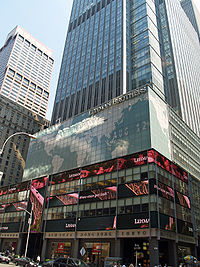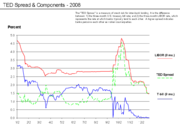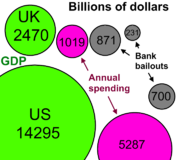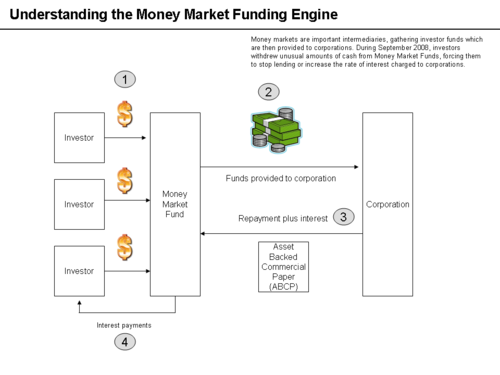News & Reading >>Reading >>Global financial crisis of 2008–2009
Global financial crisis of 2008–2009

The global financial crisis of 2008–2009 is an ongoing major financial crisis. It became prominently visible in September 2008 with the failure, merger, or conservatorship of several large United States-based financial firms. The underlying causes leading to the crisis had been reported in business journals for many months before September, with commentary about the financial stability of leading U.S. and European investment banks, insurance firms and mortgage banks consequent to the subprime mortgage crisis. Beginning with failures of large financial institutions in the United States, it rapidly evolved into a global credit crisis, deflation and sharp reductions in shipping resulting in a number of European bank failures and declines in various stock indexes, and large reductions in the market value of equities (stock) and commodities worldwide. The credit crisis was exacerbated by Section 128 of the Emergency Economic Stabilization Act of 2008 which allowed the Federal Reserve System (Fed) to pay interest on excess reserve requirement balances held on deposit from banks, removing the longstanding incentive for banks to extend credit instead of hoard cash on deposit with the Fed. The crisis led to a liquidity problem and the de-leveraging of financial institutions especially in the United States and Europe, which further accelerated the liquidity crisis, and a decrease in international shipping and commerce. World political leaders and national ministers of finance and central bank directors have coordinated their efforts to reduce fears but the crisis is ongoing and continues to change, evolving at the close of October into a currency crisis with investors transferring vast capital resources into stronger currencies such as the yen, the dollar and the Swiss franc, leading many emergent economies to seek aid from the International Monetary Fund. The crisis was triggered by the subprime mortgage crisis and is an acute phase of the financial crisis of 2007–2009.
Prelude (early September, 2008)


The subprime mortgage crisis reached a critical stage during the first week of September 2008, characterized by severely contracted liquidity in the global credit markets and insolvency threats to investment banks and other institutions. Reserve balances from banks in the Federal Reserve System began increasing over required levels of about $10 billion at the beginning of September 2008, just after the Democratic and Republican national conventions, and just before the stock market crash and presidential debates. Beginning October 6, Section 128 of the Emergency Economic Stabilization Act of 2008 allowed the Federal Reserve System to pay interest on the excess balances, producing further pressure on international credit markets. Excess on reserve balances topped $870 billion by the end of the second week of January 2009. In comparison, the increase in reserve balances reached only $65 billion after September 11, 2001 before falling back to normal levels within a month. House Representative Paul E. Kanjorski claimed in a January 27, 2009 interview with CSPAN that there was an "electronic run on the banks" during the second week of September, 2008. According to the testimony $550 Billion were withdrawn from money market accounts in the U.S. within a two hour time- span. Policymakers responded by guaranteeing up to $250,000 in money market deposits through the FDIC. Representative Kanjorski claims that if these steps had not been taken, the U.S. would have lost all its wealth within twenty-four hours.
Government takeover of home mortgage lenders
The United States director of the Federal Housing Finance Agency (FHFA), James B. Lockhart III, on September 7, 2008 announced his decision to place two United States Government sponsored enterprises (GSEs), Fannie Mae (Federal National Mortgage Association) and Freddie Mac (Federal Home Loan Mortgage Corporation), into conservatorship run by FHFA. United States Treasury Secretary Henry Paulson, at the same press conference stated that placing the two GSEs into conservatorship was a decision he fully supported, and said that he advised "that conservatorship was the only form in which I would commit taxpayer money to the GSEs." He further said that "I attribute the need for today's action primarily to the inherent conflict and flawed business model embedded in the GSE structure, and to the ongoing housing correction." The same day, Federal Reserve Bank Chairman Ben Bernanke stated in support: "I strongly endorse both the decision by FHFA Director Lockhart to place Fannie Mae and Freddie Mac into conservatorship and the actions taken by Treasury Secretary Paulson to ensure the financial soundness of those two companies."
Major financial firm crisis
On Sunday, September 14, it was announced that Lehman Brothers would file for bankruptcy after the Federal Reserve Bank declined to participate in creating a financial support facility for Lehman Brothers. The significance of the Lehman Brothers bankruptcy is disputed with some assigning it a pivotal role in the unfolding of subsequent events. The principals involved, Ben Bernanke and Henry Paulson, dispute this view, citing a volume of toxic assets at Lehman which made a rescue impossible. Immediately following the bankruptcy, JPMorgan Chase provided the broker dealer unit of Lehman Brothers with $138 billion to "settle securities transactions with customers of Lehman and its clearance parties" according to a statement made in a New York City Bankruptcy court filing. The same day, the sale of Merrill Lynch to Bank of America was announced. The beginning of the week was marked by extreme instability in global stock markets, with dramatic drops in market values on Monday, September 15, and Wednesday, September 17. On September 16, the large insurer American International Group (AIG), a significant participant in the credit default swaps markets suffered a liquidity crisis following the downgrade of its credit rating. The Federal Reserve, at AIG's request, and after AIG has shown that it could not find lenders willing to save it from insolvency, created a credit facility for up to US$85 billion in exchange for a 79.9% equity interest, and the right to suspend dividends to previously issued common and preferred stock.
Money market funds insurance and short sales prohibitions

On September 16, the Reserve Primary Fund, a large money market mutual fund, lowered its share price below $1 because of exposure to Lehman debt securities. This resulted in demands from investors to return their funds as the financial crisis mounted. By the morning of September 18, money market sell orders from institutional investors totalled $0.5 trillion, out of a total market capitalization of $4 trillion, but a $105 billion liquidity injection from the Federal Reserve averted an immediate collapse. On September 19 the U.S. Treasury offered temporary insurance (akin to FDIC insurance of bank accounts) to money market funds. Toward the end of the week, short selling of financial stocks was suspended by the Financial Services Authority in the United Kingdom and by the Securities and Exchange Commission in the United States. Similar measures were taken by authorities in other countries. Some restoration of market confidence occurred with the publicity surrounding efforts of the Treasury and the Securities Exchange Commission.
Troubled Asset Relief Program
On September 19, 2008 a plan intended to ameliorate the difficulties caused by the subprime mortgage crisis was proposed by the Secretary of the Treasury, Henry Paulson. He proposed a Troubled Assets Relief Program (TARP), later incorporated into the Emergency Economic Stabilization Act, which would permit the United States government to purchase illiquid assets, informally termed toxic assets, from financial institutions. The value of the securities is extremely difficult to determine.
Consultations between the Secretary of the Treasury, the Chairman of the Federal Reserve, and the Chairman of the U.S. Securities and Exchange Commission, Congressional leaders and the President of the United States moved forward plans to advance a comprehensive solution to the problems created by illiquid mortgage-backed securities. At the close of the week the Secretary of the Treasury and President Bush announced a proposal for the federal government to buy up to US$700 billion of illiquid mortgage backed securities with the intent to increase the liquidity of the secondary mortgage markets and reduce potential losses encountered by financial institutions owning the securities. The draft proposal of the plan was received favorably by investors in the stock market. Details of the bailout remained to be acted upon by Congress.
Week of September 21
On Sunday, September 21, the two remaining investment banks, Goldman Sachs and Morgan Stanley, with the approval of the Federal Reserve, converted to bank holding companies, a status subject to more regulation, but with readier access to capital. On September 21, Treasury Secretary Henry Paulson announced that the original proposal, which would have excluded foreign banks, had been widened to include foreign financial institutions with a presence in the US. The US administration was pressuring other countries to set up similar bailout plans. On Monday and Tuesday during the week of September 22, appearances were made by the Secretary of the Treasury and the Chairman of the Board of Governors of the Federal Reserve before Congressional committees and on Wednesday a prime-time presidential address was delivered by the President of the United States on television. Behind the scenes, negotiations were held refining the proposal which had grown to 42 pages from its original 3 and was reported to include both an oversight structure and limitations on executive salaries, with other provisions under consideration. On September 25, agreement was reported by congressional leaders on the basics of the package; however, general and vocal opposition to the proposal was voiced by the public. On Thursday afternoon at a White House meeting attended by congressional leaders and the presidential candidates, John McCain and Barack Obama, it became clear that there was no congressional consensus, with Republican representatives and the ranking member of the Senate Banking Committee, Richard C. Shelby, strongly opposing the proposal. The alternative advanced by conservative House Republicans was to create a system of mortgage insurance funded by fees on those holding mortgages; as the working week ended, negotiations continued on the plan, which had grown to 102 pages and included mortgage insurance as an option. On Thursday evening Washington Mutual, the nation's largest savings and loan, was seized by the Federal Deposit Insurance Corporation and most of its assets transferred to JPMorgan Chase.[50] Wachovia, one of the largest US banks, was reported to be in negotiations with Citigroup and other financial institutions.
Week of September 28
Early into Sunday morning an announcement was made by the United States Secretary of the Treasury and congressional leaders that agreement had been reached on all major issues: the total amount of $700 billion remained with provision for the option of creating a scheme of mortgage insurance. It was reported on Sunday, September 28, that a rescue plan had been crafted for the British mortgage lender Bradford & Bingley. Grupo Santander, the largest bank in Spain, was slated to take over the offices and savings accounts while the mortgage and loans business would be nationalized. Fortis, a huge Benelux banking and finance company was partially nationalized on September 28, 2008, with Belgium, the Netherlands and Luxembourg investing a total of €11.2 billion (US$16.3 billion) in the bank. Belgium will purchase 49% of Fortis's Belgian division, with the Netherlands doing the same for the Dutch division. Luxembourg has agreed to a loan convertible into a 49% share of Fortis's Luxembourg division. It was reported on Monday morning, September 29, that Wachovia, the 4th largest bank in the United States, would be acquired by Citigroup. On Monday the German finance minister announced a rescue of Hypo Real Estate, a Munich-based holding company comprising a number of real estate financing banks, but the deal collapsed on Saturday, October 4. The same day the government of Iceland nationalized Glitnir, Iceland’s third largest lender. Stocks fell dramatically Monday in Europe and the US despite infusion of funds into the market for short term credit. In the US the Dow dropped 777 points (6.98%), the largest one-day point-drop in history (but only the 17th largest percentage drop). The U.S. bailout plan, now named the Emergency Economic Stabilization Act of 2008 and expanded to 110 pages was slated for consideration in the House of Representatives on Monday, September 29 as HR 3997 and in the Senate later in the week. The plan failed after the vote being held open for 40 minutes in the House of Representatives, 205 for the plan, 228 against. Meanwhile US stock markets suffered steep declines, the Dow losing 300 points in a matter of minutes, ending down 777.68, the Nasdaq losing 199.61, falling below the 2000 point mark, and the S.&P. 500 off 8.77% for the day. By the end of the day, the Dow suffered the largest drop in the history of the index. The S&P 500 Banking Index fell 14% on September 29 with drops in the stock value of a number of US banks generally considered sound, including Bank of New York Mellon, State Street and Northern Trust; three Ohio banks, National City, Fifth Third, and KeyBank were down dramatically. On Tuesday, September 30, stocks rebounded but credit markets remained tight with the London Interbank Offered Rate (overnight dollar Libor) rising 4.7% to 6.88%. On Tuesday, September 30, 9 billion was made available by the French, Belgian and Luxembourg governments to the French-Belgian bank Dexia. After Irish banks came under pressure on Monday, September 29, the Irish government undertook a two year "guarantee arrangement to safeguard all deposits (retail, commercial, institutional and inter-bank), covered bonds, senior debt and dated subordinated debt (lower tier II)" of 6 Irish banks: Allied Irish Banks, Bank of Ireland, Anglo Irish Bank, Irish Life and Permanent, Irish Nationwide and the EBS Building Society; the potential liability involved is about 400 billion dollars.
Key risk indicators in September

Key risk indicators became highly volatile during September 2008, a factor leading the U.S. government to pass the Emergency Economic Stabilization Act of 2008. The “TED spread” is a measure of credit risk for inter-bank lending. It is the difference between: 1) the risk-free three-month U.S. treasury bill rate; and 2) the three-month London InterBank Offered Rate (LIBOR), which represents the rate at which banks typically lend to each other. A higher spread indicates banks perceive each other as riskier counterparties. The t-bill is considered "risk-free" because the full faith and credit of the U.S. government is behind it; theoretically, the government could just print money so that the principal is fully repaid at maturity. The TED spread reached record levels in late September 2008. The diagram indicates that the Treasury yield movement was a more significant driver than the changes in LIBOR. A three month t-bill yield so close to zero means that people are willing to forgo interest just to keep their money (principal) safe for three months – a very high level of risk aversion and indicative of tight lending conditions. Driving this change were investors shifting funds from money market funds (generally considered nearly risk free but paying a slightly higher rate of return than t-bills) and other investment types to t-bills. These issues are consistent with the September 2008 aspects of the subprime mortgage crisis which prompted the Emergency Economic Stabilization Act of 2008 signed into law by the U.S. President on October 2, 2008. In addition, an increase in LIBOR means that financial instruments with variable interest terms are increasingly expensive. For example, car loans and credit card interest rates are often tied to LIBOR; some estimate as much as $150 trillion in loans and derivatives are tied to LIBOR. Furthermore, the basis swap between one-month LIBOR and three-month LIBOR increased from 30 basis points in the beginning of September to a high of over 100 basis points. Financial institutions with liability exposure to 1 month LIBOR but funding from 3 month LIBOR faced increased funding costs. "Durvexity" spiked as markets rapidly deteriorated.[citation needed] Overall, higher interest rates place additional downward pressure on consumption, increasing the risk of recession.
Global responses
Responses in Asia/Pacific

On September 15, 2008 China cut its interest rate for the first time since 2002. Indonesia reduced its overnight repo rate, at which commercial banks can borrow overnight funds from the central bank, by two percentage points to 10.25 percent. The Reserve Bank of Australia injected nearly $1.5 billion into the banking system, nearly three times as much as the market's estimated requirement. The Reserve Bank of India added almost $1.32 billion, through a refinance operation, its biggest in at least a month. On November 9, 2008 the 2008 Chinese economic stimulus plan is a RMB¥ 4 trillion ($586 billion) stimulus package announced by the central government of the People's Republic of China in its biggest move to stop the global financial crisis from hitting the world's fourth largest economy. A statement on the government's website said the State Council had approved a plan to invest 4 trillion yuan ($586 billion) in infrastructure and social welfare by the end of 2010. The stimulus package will be invested in key areas such as housing, rural infrastructure, transportation, health and education, environment, industry, disaster rebuilding, income-building, tax cuts, and finance. China's export driven economy is starting to feel the impact of the economic slowdown in the United States and Europe, and the government has already cut key interest rates three times in less than two months in a bid to spur economic expansion. On the 28th of November, China Ministry of Finance and the State Administration of Taxation jointly announced a rise in export tax rebate rates on some labor-intensive goods. These additional tax rebates will take place on December, 1st 2008. The stimulus package was welcomed by world leaders and analysts as larger than expected and a sign that by boosting its own economy, China is helping to stabilize the global economy. News of the announcement of the stimulus package sent markets up across the world. However, Marc Faber January 16 said that China according to him was in recession. In Taiwan, the central bank on September 16, 2008 said it would cut its required reserve ratios for the first time in eight years. The central bank added $3.59 billion into the foreign-currency interbank market the same day. Bank of Japan pumped $29.3 billion into the financial system on September 17, 2008 and the Reserve Bank of Australia added $3.45 billion the same day.
U.S. responses
The Federal Reserve, Treasury, and Securities and Exchange Commission took several steps on September 19 to intervene in the crisis. To stop the potential run on money market mutual funds, the Treasury also announced on September 19 a new $50 billion program to insure the investments, similar to the Federal Deposit Insurance Corporation (FDIC) program. Part of the announcements included temporary exceptions to section 23A and 23B (Regulation W), allowing financial groups to more easily share funds within their group. The exceptions would expire on January 30, 2009, unless extended by the Federal Reserve Board. The Securities and Exchange Commission announced termination of short-selling of 799 financial stocks, as well as action against naked short selling, as part of its reaction to the mortgage crisis.
Public Response to market volatility within 401(k) and Retirement Plans
The Pension Protection Act of 2006 included a provision which changed the definition of Qualified Default Investments (QDI) for retirement plans from stable value investments, money market funds, and cash investments to investments which expose an individual to appropriate levels of stock and bond risk based on the years left to retirement. The Act required that Plan Sponsors move the assets of individuals who had never actively elected their investments and had their contributions in the default investment option. This meant that individuals who had defaulted into a cash fund with little fluctuation or growth would soon have their account balances moved to much more aggressive investments. Starting in early 2008, most employer sponsored plans sent notices to their employees informing them that the Plan default investment was changing from a cash/stable option to something new, like a Retirement Date fund which had significant market exposure. Most participants ignored these notices until September and October, when the market crash was on every news station and media outlet. It was then that participants called their 401(k) and retirement plan providers and discovered losses in excess of 30% in some cases. Call centers for 401(k) providers experienced record call volume and wait times, as millions of inexperienced investors struggled to understand how their investments had been changed so fundamentally without their explicit consent, and reacted in a panic by liquidating everything with any stock or bond exposure, locking in huge losses in their accounts. Due to the speculation and uncertainty in the market, discussion forums filled with questions about whether or not to liquidate assets and financial gurus were swamped with questions about the right steps to take to protect what remained of their retirement accounts. During the third quarter of 2008, over $72 billion left mutual fund investments that invested in stocks or bonds and rushed into Stable Value investments in the month of October. Against the advice of financial experts, and ignoring historical data illustrating that long-term balanced investing has produced positive returns in all types of markets, investors with decades to retirement instead sold their holdings during one of the largest drops in stock market history.
Loans to banks for asset-backed commercial paper

During the week ending September 19, 2008, money market mutual funds had begun to experience significant withdrawals of funds by investors. This created a significant risk because money market funds are integral to the ongoing financing of corporations of all types. Individual investors lend money to money market funds, which then provide the funds to corporations in exchange for corporate short-term securities called asset-backed commercial paper (ABCP). However, a potential bank run had begun on certain money market funds. If this situation had worsened, the ability of major corporations to secure needed short-term financing through ABCP issuance would have been significantly affected. To assist with liquidity throughout the system, the Treasury and Federal Reserve Bank announced that banks could obtain funds via the Federal Reserve's Discount Window using ABCP as collateral.
Federal Reserve lowers interest rates
| Federal reserve rates changes( Just data after January 1, 2008 ) | |||||
| Date | Discount rate | Discount rate | Discount rate | Fed funds | Fed funds rate |
|---|---|---|---|---|---|
| Primary | Secondary | ||||
| rate change | new interest rate | new interest rate | rate change | new interest rate | |
| Oct 8, 2008* | -.50% | 1.75% | 2.25% | -.50% | 1.50% |
| Apr 30, 2008 | -.25% | 2.25% | 2.75% | -.25% | 2.00% |
| Mar 18, 2008 | -.75% | 2.50% | 3.00% | -.75% | 2.25% |
| Mar 16, 2008 | -.25% | 3.25% | 3.75% | ||
| Jan 30, 2008 | -.50% | 3.50% | 4.00% | -.50% | 3.00% |
| Jan 22, 2008 | -.75% | 4.00% | 4.50% | -.75% | 3.50% |
Legislation
The Secretary of the United States Treasury, Henry Paulson and President George W. Bush proposed legislation for the government to purchase up to US$700 billion of "troubled mortgage-related assets" from financial firms in hopes of improving confidence in the mortgage-backed securities markets and the financial firms participating in it. Discussion, hearings and meetings among legislative leaders and the administration later made clear that the proposal would undergo significant change before it could be approved by Congress. On October 1, a revised compromise version was approved by the Senate with a 74-25 vote. The bill, HR1424 was passed by the House on October 3, 2008 and signed into law. The first half of the bailout money was primarily used to buy preferred stock in banks instead of troubled mortgage assets.
US Federal Reserve response
In an effort to increase available funds for commercial banks and lower the fed funds rate, on September 29 the U.S. Federal Reserve announced plans to double its Term Auction Facility to $300 billion. Because there appeared to be a shortage of U.S. dollars in Europe at that time, the Federal Reserve also announced it would increase its swap facilities with foreign central banks from $290 billion to $620 billion. As of December 24, 2008, the Federal Reserve had used its independent authority to spend $1.2 trillion on purchasing various financial assets and making emergency loans to address the financial crisis, above and beyond the $700 billion authorized by Congress from the federal budget. This includes emergency loans to banks, credit card companies, and general businesses, temporary swaps of treasury bills for mortgage-backed securities, the sale of Bear Stearns, and the bailouts of American International Group (AIG), Fannie Mae and Freddie Mac, and Citigroup.
Responses in the European Union
The European Central Bank injected $99.8 billion in a one-day money-market auction. The Bank of England pumped in $36 billion. Altogether, central banks throughout the world added more than $200 billion from the beginning of the week to September 17. On September 29, 2008 the Belgian, Luxembourg and Dutch authorities partially nationalized Fortis. The German government bailed out Hypo Real Estate. On 8 October 2008 the British Government announced a bank rescue package of around £500 billion ($850 billion at the time). The plan comprises three parts. First, £200 billion will be made available to the banks in the Bank of England's Special Liquidity scheme. Second, the Government will increase the banks' market capitalisation, through the Bank Recapitalisation Fund, with an initial £25 billion and another £25 billion to be provided if needed. Third, the Government will temporarily underwrite any eligible lending between British banks up to around £250 billion. In February 2009 Sir David Walker was appointed to lead a government enquiry into the corporate governance of banks. In early December German Finance Minister Peer Steinbrück indicated that he does not believe in a "Great Rescue Plan" and indicated reluctance to spend more money addressing the crisis.



